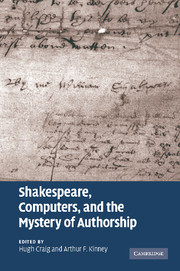Book contents
- Frontmatter
- Contents
- List of figures
- List of tables
- Notes on contributors
- Preface and acknowledgments
- 1 Introduction
- 2 Methods
- 3 The three parts of Henry VI
- 4 Authoring Arden of Faversham
- 5 Edmond Ironside and the question of Shakespearean authorship
- 6 The authorship of The Raigne of Edward the Third
- 7 The authorship of the Hand-D Addition to The Book of Sir Thomas More
- 8 The 1602 Additions to The Spanish Tragedy
- 9 Transforming King Lear
- Conclusion
- Appendix A Plays in the corpus
- Appendix B A list of 200 function words
- Glossary
- Index
- References
2 - Methods
Published online by Cambridge University Press: 06 January 2010
- Frontmatter
- Contents
- List of figures
- List of tables
- Notes on contributors
- Preface and acknowledgments
- 1 Introduction
- 2 Methods
- 3 The three parts of Henry VI
- 4 Authoring Arden of Faversham
- 5 Edmond Ironside and the question of Shakespearean authorship
- 6 The authorship of The Raigne of Edward the Third
- 7 The authorship of the Hand-D Addition to The Book of Sir Thomas More
- 8 The 1602 Additions to The Spanish Tragedy
- 9 Transforming King Lear
- Conclusion
- Appendix A Plays in the corpus
- Appendix B A list of 200 function words
- Glossary
- Index
- References
Summary
In almost anything we read there are phrases that seem to resonate with an authorial voice. Over longer stretches of writing all sorts of small signals confirm that we are in touch with a recognizable originating consciousness, even if we realize that this imagined source is our own conjecture, created from the indirect but familiar indications in what we read or hear. Without thinking about it too much, we perform an intuitive calculus on a new work or passage to test it for likeness to an authorial style we have previously internalized. The passages seem to us either authentic or not.
But what, say, of Hal, Hotspur, and Falstaff? They inhabit the same play, but each has a recognizable style that sets him apart from the other two. Can there be a single, identifiable Shakespearean language that unites their three very different kinds of speech? What could it be about the way they speak that would actually unite them, and separate them from characters created by other writers of the same time writing in the same genre, and even drawing on the same conventions of the wily villain, the vainglorious soldier, the braggart hero, and so on?
There are other impediments to identifying an authorial style in a systematic way. For instance, how can we be sure that some of the distinctive Shakespearean phrasings are not in fact common expressions from his own time?
- Type
- Chapter
- Information
- Shakespeare, Computers, and the Mystery of Authorship , pp. 15 - 39Publisher: Cambridge University PressPrint publication year: 2009
References
- 1
- Cited by



